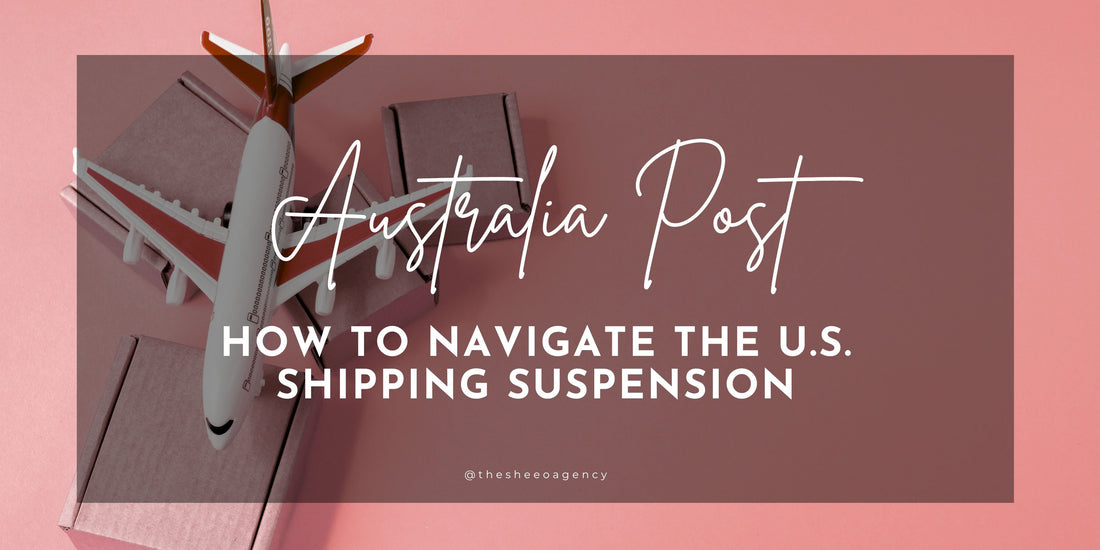
Australia Post Suspends U.S. Shipping: A Survival Guide for Metro and Rural Businesses
⚠️ Update – October 2025
Australia Post has now resumed parcel deliveries to the United States for business customers (from 22 Sept) and will reopen retail Post Office lodgements on or before 7 Oct. New U.S. import rules mean duties and taxes must be prepaid, and stricter customs declarations are required.
👉 Read our updated guide here for the latest steps every Australian product business needs to follow to keep shipping smoothly.
On 26 August 2025, Australia Post made the unprecedented move to suspend most parcel deliveries to the United States.
For businesses across Australia—whether you’re based in Melbourne, Sydney or a rural town—this has created real disruption. For many, Australia Post has been the simplest way to send orders abroad, especially to the lucrative U.S. market.
Here’s what’s happening, what it means for you, and what you can do right now depending on whether you’re in a metro or rural location.
Why Is This Happening?
The U.S. has ended its “de minimis” exemption. This used to allow parcels under US $800 (~AUD 1,230) to enter without duties or taxes.
- From 29 August, all parcels (no matter the value) require duties and taxes to be prepaid before shipping.
- Australia Post isn’t yet set up to process this, so they’ve suspended services until further notice.
- What’s still allowed? Only letters, documents, and gifts under US $100.
Australia Post is currently working with U.S. Customs and Zonos (a customs intermediary) on a prepaid duties system—but there’s no confirmed restart date yet.
What to Do Now (Metro Businesses)
If you’re in a city or metro hub, you’ve got more courier options on your doorstep:
-
Switch to DHL or FedEx immediately.
- Both have strong metro coverage, reliable pickups, and online tools to manage shipments.
- Sign up for a business account so you can arrange regular collections and access better rates.
-
Use Sendle if you’re SME-focused.
- Sendle’s recent expansion (via FAST Group in the U.S.) gives them more international reach.
- They’re especially good for small-to-medium order volumes.
-
Be transparent with customers.
- Explain higher shipping costs or potential delays upfront.
- Consider adding a duty/tax calculator at checkout so U.S. customers aren’t surprised.
-
Think ahead.
- If the U.S. is a big part of your sales, now might be the time to explore U.S.-based warehousing or 3PL partners for fulfilment.
What to Do Now (Rural Businesses)
If you’re outside the city, losing Australia Post hits harder—because many couriers don’t offer the same level of pickup convenience. But you still have options:
-
Check DHL and FedEx pickup coverage.
- Both do offer door-to-door pickups in many regional areas if you have an account.
- If your exact location isn’t covered, look at the nearest drop-off or service point.
-
Investigate Sendle.
- Sendle partners with local carriers in regional areas, so they may have better pickup availability.
- Even if it requires drop-off, their SME focus can be more cost-effective.
-
Work together with other businesses.
- Consider consolidating shipments with nearby retailers so you can book regular courier pickups.
- A local café, store, or co-op could act as a shared drop-off hub.
-
Keep customers close.
- Rural businesses often thrive on community and customer loyalty—make sure your U.S. buyers feel informed and supported with honest communication.
Understanding Shipping Rates and Duties
This part matters because your customers will ask: Why is shipping more expensive? Who pays the taxes?
How the Rates Compare
- DHL is often the most cost-effective for international parcels and is usually faster (1–3 business days).
- FedEx can be slightly pricier, but they have strong U.S. domestic coverage—making them useful if you need onward shipping once the parcel lands.
- Sendle is built for SMEs. Pricing is simplified and often cheaper for small to medium volumes, though coverage in regional areas depends on their local partners.
How Duties and Taxes Are Handled
- DHL → Receiver usually pays. DHL contacts them directly and provides a payment link.
- FedEx → Flexible: shipper, recipient, or third party can pay. If not specified, the receiver pays, but the sender is liable if they refuse.
- Sendle (current model) → Delivered At Place (DAP): receiver pays duties on delivery.
- Sendle (coming soon) → Delivered Duty Paid (DDP): sender pays upfront, so the customer isn’t hit with a surprise bill.
Duty & Tax Calculator Tools for Websites
To avoid awkward surprises, you can integrate a duty/tax calculator directly at checkout—so customers see the “landed cost” (product + shipping + duties/taxes) before they confirm payment.
For Shopify Stores
- Zonos Duty and Tax – Full compliance and remittance with guaranteed landed cost quotes.
- DHL Duty and Tax Calculator – Real-time duty/tax display at checkout, carrier-agnostic.
- Swap Global – End-to-end DDP shipping, with automatic tax/duty collection.
- Duty and Tax Calculator App (by DutyandTax.app) – Local currency duty/tax collection at checkout.
- Shopify’s Native Duties Tool – Recently extended to all plans; collects duties at checkout with a small transaction fee.
For WooCommerce Stores
- Dutify – Calculates and charges duties/taxes automatically for landed cost clarity.
- Calcurates – Supports HS codes, country of origin, DDP/DDU logic, and integrates with carriers.
- WooCommerce Shipping & Tax (Official) – Automates sales tax based on customer location.
- Quaderno – Global tax/VAT/GST compliance with automated invoicing.
- Crossborderit (CBIT) – IOSS VAT reporting + duty/tax calculation, great for EU.
- DutyCalculator Plugin – API-driven tool for landed cost in 140+ countries.
- 👉 Adding one of these tools ensures your customers know upfront whether they’ll pay duties at checkout or on delivery—building trust and transparency.
Quick Comparison: Providers at a Glance
| Carrier | Rural Pickup? | Setup Needed | Best For | Duty Handling |
|---|---|---|---|---|
| DHL Express | Yes (with account) | DHL account | Fast, reliable | Receiver pays (via DHL link) |
| FedEx | Yes (book online) | FedEx account / ID | Flexible scheduling | Shipper/receiver/3rd party |
| Sendle / FAST | Some areas via partners | Sendle account | SME-friendly | Currently DAP (receiver pays), DDP coming soon |
| Freight Forwarders | Metro drop-off only | Forwarder account | Bulk, cost-efficient | Usually receiver pays |
Final Takeaway
My tip of the day is whether you’re running a boutique in Sydney or handcrafting products on a farm in Daylesford, the message is the same: don’t wait for Australia Post to solve this.
- Metro businesses: Switch fast to DHL, FedEx, or Sendle, and consider warehousing if the U.S. is a major market.
- Rural businesses: Push for courier accounts with pickup coverage, collaborate locally, and keep your U.S. customers in the loop.
Its great news that Australia Post is working on a solution with Zonos, but until then you cant afford to let your presence in the US market fall away, resilience comes from diversification, transparency, and agility.
This challenge may just spark smarter systems, stronger customer trust, and new growth opportunities for your business.
If you need any assistance navigating your shipping challenges to the US, contact us as we very experienced in managing US exports.
Felicity x
